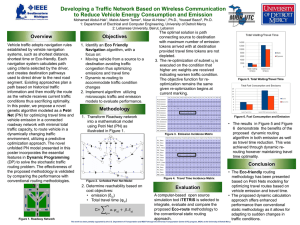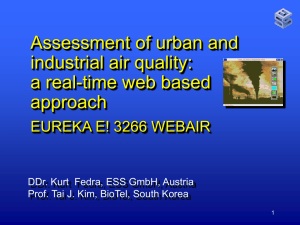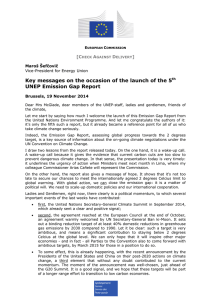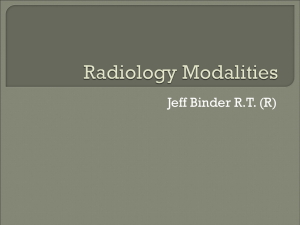Thermal Bremsstrahlung - Extreme Universe Laboratory
advertisement
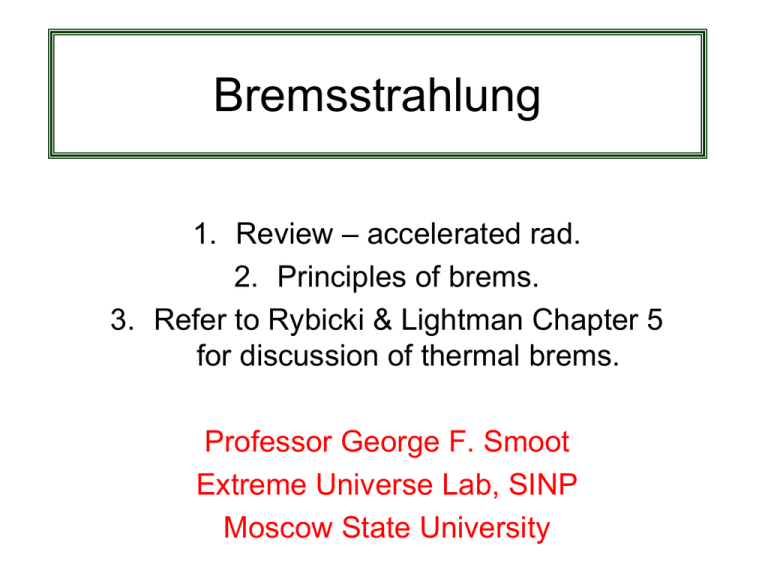
Bremsstrahlung 1. Review – accelerated rad. 2. Principles of brems. 3. Refer to Rybicki & Lightman Chapter 5 for discussion of thermal brems. Professor George F. Smoot Extreme Universe Lab, SINP Moscow State University BREMSSTRAHLUNG RADIATION Bemsstrahlung is a German word directly describing the process: "Strahlung" means "radiation", and "Bremse" means "brake. An incoming free electron can get close to the nucleus of an atom (or other charged particle), the strong electric field of the nucleus will attract the electron, thus changing direction and speed of the electron – accelerating it. An energetic electron loses energy by emitting an X-ray photon and less energetic will emit lower energy photons. The energy of these photons will depend on the degree of interaction between nucleus and electron, i.e. the passing distance as well as the initial energy of the electron. Several subsequent interactions between one and the same electron and different nuclei are possible. X-rays originating from this process are called bremsstrahlung. Lower energy photons from this process are often called free-free emission. Free-free because the electron is free before and free after. Compare to bound-bound and free-bound interactions Bremsstrahlung Short Review of Radiation from an Accelerated Charge – e.g. brems • A charged particle accelerating in a vacuum radiates power, as described by the Larmor formula and its relativistic generalizations. Although the term "bremsstrahlung" is usually reserved for charged particles accelerating in matter, not vacuum, the formulas are similar. ( ) 2ö æ 2ö e 2g 4 ç 2 b · b ÷ e2g 6 æ 2 P= çb + ÷= çb - b ´ b ÷ 2 6pe 0 c ç 1- b ÷ 6pe 0 c è ø è ø ( ) Review continued: Angular Distribution • where n is a unit vector pointing from the particle towards the observer, and dW is a infinitesimal bit of solid angle. • In the case where velocity is parallel to acceleration (for example, linear motion), this simplifies to Quantum Process Where Z is atomic number An analysis of the doubly differential cross section above shows that electrons whose kinetic energy is larger than the rest energy (511 keV) emit photons in forward direction while electrons with a small energy emit photons isotropically. For a short constant acceleration Spectrum produced in the Bremsstrahlung process. The spectrum is flat up to a cutoff frequency wcut, and falls off exponentially at higher frequencies. X-ray tube • In an X-ray tube, electrons are accelerated in a vacuum by an electric field and shot into a piece of metal called the "target". X-rays are emitted as the electrons slow down (decelerate) in the metal. The output spectrum consists of a continuous spectrum of X-rays, with additional sharp peaks at certain energies (see graph on right). The continuous spectrum is due to bremsstrahlung, while the sharp peaks are characteristic X-rays associated with the atoms in the target. For this reason, bremsstrahlung in this context is also called continuous X-rays. pm is picometers he t emperat ure of t he elect rons along t he line of sight is roughly const ant , t hat t he elect ron t em re is great er than 20K , t he frequency is smaller t han 100 GHz, and t hat t he Gaunt fact or can be sed as a product of powers of t he frequency and t he elect ron t emperat ure. [19],[20]. est imat e of t he bright ness t emperat ure for free-free emission can be found from t he radiat ive ort equat ions Simple Bremsstrahlung Formula for free-free radiation Tbf f = ≈ ∼ Te (1 − e− τ ν ) ≈ τ ν Te (8) 10 GH z 2 104 K 1/ 2 E M 5.43µK ( ) ( ) ( − 6 ) < gf f > ν Te cm pc 10 GH z 2.1 104 K 0.35 E M 26µK ( ) ( ) ( −6 ) ν Te cm pc (9) (10) • Makes it easy to estimate the bremsstrahlung < g > ≈ 4.69 × [1 + 0.176l n(T / 10 K ) − 0.118l n(ν/ 10 GH z)] (11) produced radiation field for a reasonable t ables and formula can be found many places [20]. temperature plasma. 2 • For much hotter plasma one must take the gaunt factor in to more careful account. • For reasonable temperature there is log rise proximat ion for t he velocity-averaged Gaunt fact or < g(ν, Te ) > is [26]: ff e 4 Bremsstrahlung • Probability of bremsstrahlung production per atom is proportional to the square of Z of the absorber • Energy emission via bremsstrahlung varies inversely with the square of the mass of the incident particle – Protons and alpha particles produce less than one-millionth the amount of bremsstrahlung radiation as electrons of the same energy Bremsstrahlung • Ratio of electron energy loss by bremsstrahlung production to that lost by excitation and ionization = EZ/820 – E = kinetic energy of incident electron in MeV – Z = atomic number of the absorber • Bremsstrahlung x-ray production accounts for ~1% of energy loss when 100 keV electrons collide with a tungsten (Z = 74) target in an x-ray tube Thermal Bremsstrahlung • The emission of a single electron, with impact parameter b and velocity v. 8Z 2 e6 I= 3pc3me2 v 2 b2 • We would now like to generalize the results to a population of electrons with a certain velocity and density distribution. An astrophysically useful case is for a population with a uniform temperature T. The total emission by all particles in this population is called thermal bremsstrahlung. • Consider an cloud of ionised gas with a characteristic temperature T. The velocity distribution of the particles in this cloud is given by the Maxwell distribution. • In cgs units the power emitted per cubic cm is eff = 1.4 ´10-27 T1/2 ne ni Z 2 gB • Here, gB is the frequency averaged gaunt factor for the thermal distribution of velocities, and is of order unity. Thermal Bremsstrahlung Power Spectrum The bremsstrahlung power spectrum rapidly decreases for large photon energy, and is also suppressed near the Electron plasma frequency wp. This plot is for the quantum case . Bethe-Heitler Eqn An analysis of the doubly differential cross section above shows that electrons whose kinetic energy is larger than the rest energy (511 keV) emit photons I n forward direction while electrons with a small energy emit photons isotropically. Thermal Issues So what sort of temperatures and energies are involved in high energy thermal radiation? First let’s review a few equations related to electromagnetic radiation. To calculate the thermal source temperature we use Wien’s law: 2.898 x106 nm K T= max Recall that wavelength and frequency = are related via: c where c is the speed of light The photon energy and momentum are related to frequency via: E = h and Momentum = h / c where h is Planck’s constant This means that when a photon loses energy and momentum, its frequency decreases. Click here to be reminded about the physical constants and units used. Gamma & X-rays Ranges Armed with these equations, we can now see what thermal temperatures and energies are involved in high energy radiation: • Gamma radiation is generally defined by photons with < 0.001 nm, which corresponds E >1.24 MeV and T >108 K. Such high energy photons are created in nuclear reactions and other very high energy processes. • X-rays are those photons in within the wavelength range 0.001 nm < < 10 nm, with 124 eV < E < 1.24 MeV and 106 K < T < 108 K. These high energy photons are created, for example, in supernovae remnants and the solar corona, as well as in the hot gas between galaxy clusters. Types of Thermal Radiation • You are familiar with atomic excitation and de-excitation as a means of producing photons. Thermal atomic excitation is generally via collisions, which excite atoms, and as they de-excite, they emit photons. The hotter the medium, the higher the kinetic energy of the impacts, and the higher the resulting photon energy. photon Thermal Bremsstrahlung As well as atomic excitation, another thermal process is bremsstrahlung radiation, which occurs when free electrons interact with ions in, for example, the hot atmospheres of stars. If a negative electron approaches a positive ion, they will be attracted to each other and the strong electric force will alter the trajectory of the electron (i.e. accelerating it), which leads to electromagnetic radiation being emitted: H+ e- photon This type of emission form is called free-free emission, or thermal bremsstrahlung - which is German for “braking radiation”. Energy of Thermal Bremsstrahlung The frequency range of the radiation depends on how much the electron’s trajectory is bent by the interaction with the positive ion. This depends on several things, including the relative velocities of the two bodies, which in turn depends on the temperature of the gas, which is why free-free emission is a thermal process. An example of high energy thermal bremsstrahlung is the X-ray emission from giant elliptical galaxies and hot intercluster gas. X-ray image of hot intercluster gas in Hydra A Bremsstrahlung Radiation Movie of the bremsstrahlung process BREMSSTRAHLUNG ON HEAVY NUCLEUS Movie of bremsstrahulung on a heavy nucleus with bound electrons. This is more relevant to detectors and man-generated x-rays than astro DIFFERENT DEGREES OF DECCELERATION X-RAYS HEAT BREMS RADIATION IS: POLYENERGETIC ! 90% OF X-RAYS ARE PRODUCED THROUGH BREMS INTERACTIONS WHEN 80-100 KVP APPLIED BREMS EMISSIONCONTINUOUS Characteristic X-rays The high energy electron can also cause an electron close to the nucleus in a metal atom to be knocked out from its place. This vacancy is filled by an electron further out from the nucleus. The well defined difference in binding energy, characteristic of the material, is emitted as a monoenergetic photon. When detected this X-ray photon gives rise to a characteristic X-ray line in the energy spectrum. Characteristic Radiation KE OF PROJECTILE ELECTRON > BINDING ENERGYORBITAL ELECTRON CHARACTERISTIC CASCADE TUNGSTEN-74 BINDING ENERGIES OF DIFFERENT SHELL ELECTRONS K-70 KEV L-12 KEV M-2.8 KEV CHARACTERISTIC X-RAYS L K M K 70-3 = 67 keV L 12-3 = 9 keV M 70-12 = 58 keV Bremsstrahlung Bremsstrahlung “Free-free Emission” “Braking” Radiation Radiation due to acceleration of charged particle by the Coulomb field of another charge. Relevant for (i) Collisions between unlike particles: changing dipole emission e-e-, p-p interactions have no net dipole moment (ii) e- - ions dominate: acc(e-) > acc(ions) because m(e-) << m(ions) recall P~m-2 ion-ion brems is negligible Method of Attack: (1) emission from single epick rest frame of ion calculate dipole radiation correct for quantum effects (Gaunt factor) (2) Emission from collection of e thermal bremsstrahlung or non-thermal bremsstrahlung (3) Relativistic bremsstrahlung (Virtual Quanta) A qualitative picture Emission from Single-Speed Electrons e- b v R Electron moves past ion, assumed to be stationary. b= “impact parameter” Ze ion - Suppose the deviation of the e- path is negligible small-angle scattering The dipole moment the encounter. d = -eR - Recall that for dipole radiation where ˆ w) d( is a function of time during 2 energy dW 8pw 4 ˆ = = d (w ) 3 frequency dw 3c is the Fourier Transform of d After some straight-forward algebra, (R&L pp. 156 – 157), one can derive dW(b) dw in terms of impact parameter, b. Now, suppose you have a bunch of electrons, all with the same speed, v, which interact with a bunch of ions. Let ni = ion density (# ions/vol.) ne = electron density (# electrons / vol) The # of electrons incident on one ion is ne v = # electrons/area/time # e-s /Vol d/t Area = 2p b db around one ion, in terms of b So total emission/time/Vol/freq is dW dW (b) = n e n i 2pv ò bdb dw dV dt dw Again, evaluating the integral is discussed in detail in R&L p. 157-158. We quote the result Energy per volume per frequency per time due to bremsstrahlung for electrons, all with same velocity v. dW 16pe 6 1 2 = n n Z g ff (v,w ) e i 3 2 dwdVdt 3 3c m v ne = electrons/vol. ni = ions/vol Z = # of charges in ion g ff (v, w ) = Gaunt factor Gaunt factors are quantum mechanical corrections function of e- energy, frequency Gaunt factors are tabulated (more later) Naturally, in most situations, you never have electrons with just one velocity v. Maxwell-Boltzmann Distribution Thermal Bremsstrahlung Average the single speed expression for dW/dwdtdV over the Maxwell-Boltzmann distribution with temperature T: dW = dVdtdw The result, with ò 2ö æ dW (v, w ) 2 mv v exp ç ÷ dv dw dVdt è 2kT ø 2ö æ mv 2 ò v exp çè- 2kT ÷ø dv dw = 2p dn dW 2 p e æ 2p ö -1/2 2 -hn /kT = g ff ÷ T Z neni e 3 ç dVdtdn 3mc è 3km ø 5 6 1/2 g ff = velocity averaged Gaunt factor where In cgs units, we can write the emission coefficient dW en = = 6.8´10-38 Z 2 ne niT -1/2 e-hn /kT g ff dVdtdn ff Free-free emission coefficient ergs /s /cm3 /Hz Integrate over frequency: dW 2 pe æ 2pkT ö 2 = ÷ Z ne ni gB 3ç dVdt 3hmc è 3km ø 5 where In cgs: 6 1/ 2 gB = frequency average of the velocity averaged Gaunt factor en ff dW = = 1.4 ´10 -27 Z 2 n e n iT1/ 2 gB dVdt Ergs sec-1 cm-3 g ff (T, n ) The Gaunt factors - Analytical approximations exist to evaluate them - Tables exist you can look up - For most situations, hn g ff ~ 1 for 10 £ £1 kT -4 so just take g ff » 1.2 Numerical Values of gaunt factor Handy table, from Tucker: Radiation Processes in Astrophysics ff Important Characteristics of Thermal Bremsstrahlung Emissivity (1) Usually optically thin. Then ff (2) ff is ~ constant with hν at low frequencies hn << kT (3) ff falls of exponentially at hn ~ kT VLA (radio region) ``image'' of Perseus A, overlayed on the X-ray image from the Chandra telescope. The central source is clearly seen, as well as radio lobes which loosely coincide with the two circum-nuclear ``bubbles'' in the X-ray image. Examples: Important in hot plasmas where the gas is mostly ionized, so that bound-free emission can be neglected. T (oK) Obs. of ff Solar flare 107 (~ 1keV) radio flat X-ray exponential H II region 105 radio flat Orion 104 radio-flat Sco X-1 108 optical-flat X-ray flat/exp. Coma Cluster ICM 108 X-ray flat/exp. Bremsstrahlung (free-free) absorption Brems emission photon e- eion photon e- collateral Inverse Bremss. free-free abs. Recall the emission coefficient, jν, is related to the absorption coefficient αν for a thermal gas: ff in cgs: jn = an Bn (T) enff = 4p jnff and thus 1/ 2 6 æ ö 4e 2 p 2 -1/ 2 -3 -hn / kT anff = g ff ç ÷ n e n i Z T n (1- e ) 3mhc è 3km ø is isotropic, so anff = 3.7 ´108 ne ni Z 2T -1/ 2n -3 (1- e-hn / kT ) g ff Important Characteristics of (1) hn >> kT ff (e.g. X-rays) an = 3.7´10 neni Z T ff 8 2 n g ff -1/2 -3 Because of T n term, is very small unless ne is very large. -1/2 -3 ff in X-rays, thermal bremsstrahlung emission can be treated as optically thin (except in stellar interiors) (2) hn << kT e.g. Radio: Rayleigh Jeans holds an = 0.018 neni Z T ff 2 n g ff -3/2 -2 Absorption can be important, even for low ne in the radio regime. From Bradt’s book: BB spectrum is optically thick limit of Thermal Bremss. HII Regions, showing free-free absorption in their radio spectra: R&L Problem 5.2 Spherical source of X-rays, radius R distance L=10 kpc flux F= 10 -8 erg cm-2 s-1 (a) What is T? Assume optically thin, thermal bremsstrahlung. Turn-over in the spectrum at log hν (keV) ~ 2 Emax 9 o T= » 10 K k (b) Assume the cloud is in hydrostatic equilibrium around a central mass, M. Find M, and the density of the cloud, ρ 1 4p R3 ff F= en 2 4p L 3 Vol. emission coeff. 1/r2 Vol. 1 4pR 3 -27 -1/ 2 2 F= 1.4 ´ 10 T n n Z gB ) ( e i 2 4pL 3 - Since T=109 K, the gas is completely ionized - Assume it is pure hydrogen, so ni = ne, then ni ne » nH2 ρ=mass density, g/cm3 æ r ö 47 2 @ç = 3.6 ´10 r ÷ è mH ø 2 Z=1 since pure hydrogen gB =1.2 F = 2.0 ´10 r T R L 20 2 1/2 3 -2 (1) - Hydrostatic equilibrium another constraint upon ρ, R Virial Theorem: æ K.E. ö æ grav.energy ö 2 ´ç ÷ = -ç ÷ è particle ø è particle ø GMmH 3kT = R For T=109 K æ M ö R = 5´10 ç ÷ cm è M sun ø (2) 8 -3/2 - Eqn (1) & (2) æ M ö -26 1/2 r = 4 ´10 LF ç ÷ è M sun ø Substituting L=10 kpc, F=10-8 erg cm-2 s-1 -3/2 æ M ö -7 -3 r = 4 ´10 g cm ç ÷ è M sun ø Fr ee-Fr ee Em ission = ≈ = = 4e2 2π 2 ( ) N e N i Z 2 Te− 3/ 2 ν − 2 < gf f > 3m e hc 3km e 0.018 Z 2 N e N i Te− 3/ 2 ν − 2 < gf f > 4e2 2π 2 ( ) N e N i Z 2 Te− 1/ 2 ν − 3 (1 − e− h ν / k T e ) < gf f > 3m e hc 3km e 3.7 × 108 Z 2 N e N i Te− 1/ 2 ν − 3 (1 − e− h ν / k T e ) < gf f > (4) (3) (2) (1) ≈ = = N e N i dl < gf f > = 0.018 Te− 3/ 2 ν − 2 E M < gf f > 0.0543 Te− 1.5 ( ν EM )− 2( ) < gf f > 1 GH z cm − 6 pc ν EM 0.08235 Te− 1.35 ( ) − 2.1 ( − 6 ) 1 GH z cm pc 0.018 Te− 3/ 2 ν − 2 (7) (6) (5) ∼ ≈ = 4 5.43µK ( 10 GH z 2 10 K 1/ 2 E M ) ( ) ( ) < gf f > ν Te cm − 6 pc 10 GH z 2.1 104 K 0.35 E M 26µK ( ) ( ) ( −6 ) ν Te cm pc Te (1 − e− τ ν ) ≈ τ ν Te 2 det ail t ables and formula can be found many places [20]. < gf f > ≈ 4.69 × [1 + 0.176l n(Te/ 104 K ) − 0.118l n(ν/ 10 GH z)] An approximat ion for t he velocity-averaged Gaunt fact or < g(ν, Te ) > is [26]: Tbf f (11) (10) (9) (8) where t he emission measure E M is defined as: E M ≡ N e N i dl . T he bright ness spect rum has a − 2.1 ± 0.03 spect ral index, wit h weak dependency on t he t emperat ure and density of t he int erst ellar plasma and t he observing frequency. T he Gaunt fact or account s for t his small dependency. T his formula (Eqn. 7) is based on t he assumpt ions t hat t he int erst ellar plasma is elect rically neut ral, t hat t he t emperat ure of t he elect rons along t he line of sight is roughly const ant , t hat t he elect ron t emperat ure is great er t han 20K , t he frequency is smaller t han 100 GHz, and t hat t he Gaunt fact or can be expressed as a product of powers of t he frequency and t he elect ron t emperat ure. [19],[20]. An est imat e of t he bright ness t emperat ure for free-free emission can be found from t he radiat ive t ransport equat ions τν where t he approximat ion is for hν < < kTe and < gf f > is t he velocity averaged Gaunt fact or. Int egrat ion along t he line of sight gives t he formula for t he opt ical dept h τ ν t o free-free as αν Radio-frequency free-free emission arises from t he int eract ion of free elect rons wit h ions, and consist s of t hermal bremsst rahlung radiat ion. Free-free emission is t he bremsst rahlung (braking radiat ion) t hat occurs when a fast charged part icle (in t his ast rophysical case t hermally hot elect rons) is accelerat ed in an encount er wit h an at om, molecule, or ion. Free-free emission is so named since t he elect ron st art s in a free (unbound) st at e and ends in an unbound st at e as opposed t o being capt ured int o a bound st at e (free-bound emission) or making a t ransit ion from one bound level t o anot her (bound-bound emission). When t he elect ron ent ers t he Coulomb field, it is accelerat ed and emit s radiat ion in a readily calculable manner. In an ast rophysical plasma, such as t hose t hat exist in our Galaxy one must int egrat e over t he t ot al dist ribut ion of elect rons and ions t o obt ain an expression for t he volume or line of sight emissivity. T he velocity averaged Gaunt fact or < gef f > t akes int o account t he dist ribut ions and t he quant um mechanical cut off in scat t ering emission. T he volume absorpt ivity/ emissivity of a plasma for elect ron-ion bremsst rahlung is [15], [20] 2 Fr ee-Fr ee Signal H α Em ission R elat ion bet ween H α & Fr ee-fr ee Emission EM T )( )− γ cm − 6 pc 104 K 106 phot ons/ (cm2 s st er) = 2.41 × 10− 7 ergs/ (cm2 s st er) 4π (13) (12) ≈ = 7µK ( T ) 0.55 104 K to 1.68µK < gf f > ( T λ 2 Iα ) 0.4 t o 0.7 ( ) ( ) 104 K 1 cm R λ I α 0.85 ( ) 2.1 ( ) 1 cm R (15) (14) R esult s fr om H α Sur veys 3 T he major Hα st ruct ures form t he well-known Local (Gould Belt ) Syst em which ext ends 30◦ -40◦ from t he plane at posit ive b in t he Galact ic cent re and at negat ive lat it ude in t he ant icent re. T he HI and dust in t he Local Syst em may be t raced t o 50◦ from t he Galact ic plane. Ot her Hα feat ures are also found ext ending 15◦ -20◦ from t he plane [23]. Quant it at ivemeasurement s are now availablefrom accurat e spect roscopy (e.g. Reynolds 1992, Bart let t et al. 1997). To first order t he Hα may be approximat ely modelled as a layer parallel t o t he Galact ic plane wit h a half-t hickness int ensity of 1.2 Rayleigh (R). T he rms variat ion in t his Hα emission is roughly 0.6R on degree scales. T he four-year COBE DMR sky maps at different frequencies have been ut ilized t o isolat e emission wit h ant enna t emperat ure which varies proport ional t o frequency t o t he -2.15 power (∝ ν − 2.15 ) [9] in an at t empt t o provide a large angular scale map of free-free emission at 53 GHz. T his low-signal t o noise 4.2 so t hat for example Tbf f (30 GH z) = 7µK (I α / R), Tbf f (45 GH z) = 3µK (I α / R), and Tbf f (53 GH z) = 2µK (I α / R). A typical measured value for I α is order of 1 R. Tbf f at a wavelengt h λ H α = 6563 Angst roms. Combining t he free-free and Hα equat ions one finds a relat ion between t he low-t emperat ure Hα int ensity and t he free-free emission 1R ≡ 1Rayl i egh ≡ for T ≤ 2.6 × 104 K and where γ varies from 0.9 for Te ≤ 2.6 × 104 K t o 1.2 for Te > 2.6 × 104 K , I α = 0.36R( Diffuse Galact ic Hα is t hought t o be a good t racer of diffuse free-free emission since bot h are emit t ed by t he same ionized medium and bot h have int ensit ies proport ional t o emission measure (t he line of sight int egral of t he free elect ron density squared, ∝ N e2 dl ). T he int ensity of Hα emssion is given [16],[11] by 4.1 At present most of t he informat ion current ly available about t he source of free-free radiat ion at int ermediat e and high lat it udes comes from Hα surveys. 4 Free-free emission is t he least well known of t he Galact ic emissions. It is not easily indent ified at radio frequencies, except near t he Galact ic plane. At higher lat it udes free-free emission must be separat ed from synchrot ron emission by virt ue of t heir differing spect ral indices. At frequencies less t han about 10 GHz synchrot ron emission dominat es at int ermediat e and high lat it udes. At higher frequencies where free-free emission might be expect ed t o exceed t he synchrot ron component , t he signals are weak and survey zero levels are indet erminat e. 3 EM (cm − 6 pc) 0.004 [21] 2.9 csc|b| [16] 0.024 [21] 0.5-1.0 [30] Est im at es of Fr ee-Fr ee Em ission T (K ) 105.9 104 106.2 104 ∼ 106 Iα (R) 3 × 10− 5 1 9 × 10− 5 0.2-0.37± 0.02 Tbf f (30 GHz) (µK ) 10− 3 5 - 40 7 × 10− 3 2-4 ∼ 0.1 X -r ay Em ission I nfor m at ion (17) 6.8 × 10− 38 Z 2 N e N i Te− 1/ 2 e− h ν / k T e < gf f > ergs− 1 cm− 3 = = = = N e N i dl Te− 1/ 2 Z 2 e− h ν / k T e < gf f > ergs− 1 cm− 3 2.12 × 10− 20 EM T − 1/ 2 Z 2 e− h ν / k T e < gf f > ergs− 1 cm− 2 cm − 6 pc e EM 3.3 × 103 − 6 Z 2 Te− 1/ 2 e− h ν / k T e < gf f > keVs− 1 cm− 2 keV − 1 cm pc 6.8 × 10− 38 (20) (19) 5 X-ray emission is a good t racer of radio free-free emission when t he plasma is sufficient ly hot t o produce x-rays via t hermal bremst rahlung. T hat is t hey bot h arise from t he same mechanism but are t he opposit e ext remes of hν/ kTe . T hus t hey have essent ially t he same coef f ci ient s except t he Bolt zmann suppression fact or is very import ant for x-rays. One can t hen use t he x-ray observat ions t o provide an est imat e and upper limit versus t emperat ure for t he radio free-free emission. A summary of t he observat ions, Hα predict ion, and t he x-ray limit s are shown in Figure 3. (Not e t hat t he OVRO [11] observat ions of about 200 µK at 14.5 GHz ext rapolat e t o be roughly 13 µK at 53 GHz; dE dtdνdA (18) (16) 32πe6 2π 1/ 2 − 1/ 2 2 − h ν / k T e ]( ) Te Z e < gf f > 3mc3 3km e [ = Int egrat ing over t he line of sight one finds dE dtdνdV T he volume emission by t hermal bremsst rahlung is 8 Table 1 present s measurement s and est imat es of t he Galact ic ionized emission regions. Using t he formulae relat ing t he free-free emission t o t he plasma t emperat ure and emission measure and t o Hα emission one derives t he signals shown. T he numbers for t he Galact ic free-free emission derived t his way are a fact or of two below what one finds using t he slope (fit t ing t o csc|b|) COBE DMR free-free map. T he DMR free-free map does not have a st rong signal-t o-noise rat io and shows a high degree of correlat ion wit h t he Galact ic dust emission[9] which may or may not be free-free emission[5]. For t hat reason it is more reliable and consist ent t o t race t he propert ies of t he ionized int erst ellar medium t hrough it s Hα emission. T he major quest ion is: How much hot (T > > 104 K ) gas is t here in t he int erst ellar medium? Could t here be enough t o make up t he fact or of two? T he x-ray and pulsar dispersion measurement s put a t ight limit on t he possible addit ional free-free emission. T he pulsar dispersion measurement s are consist ent wit h an emission measure of approximat ely 1 csc|b| / (cm − 6 pc) if all t he ionizat ion is spread evenly and uniformly. T he est imat e is higher by t he fract ional filling fact or. T he filling fact or is est imat ed t o be of order 0.1 t o 0.4, increasing wit h increasing Galact ic lat it ude. 7 Local Bubble Disk Region (∼ 1 kpc) Halo Magellanic St ream Local Group Corona Region Table 1: Est imat es of Hα & Free-free emission Fr ee-fr ee–D ust C or r el at i on Tf f / I 100µ m frequency ( µK (MJy/ sr) − 1 ) (GHz) 75 (ν/ 23) − 2.2 18.06 ± 2.54 31.5 6.88 ± 1.40 53 2.76 ± 1.61 90 15.0 ± 8.1 40 H α–D ust C or r el at i on I H α / I 100µ m frequency ( Rayleigh (MJy/ sr) − 1 ) 0.85 ± 0.44 Hα 0.34 ± 0.33 Hα 0.79+− 0.44 Hα 0.15 I m pl i ed fr om Fr ee-fr ee Te ≈ 104 K 6 2.0 ± 0.5 50 3.6 ± 2 71◦ (deg) 144◦ b (deg) NCP |b| > 20◦ NCP b (deg) − 21◦ NCP − 67◦ NCP (deg) NCP |b| > 20◦ H α & Fr ee-Fr ee vs. D ust Em ission Cor r elat ion Conclusions T he est imat ion of radio (e.g. 53 GHz) free-free emission is not a complet ely set t led issue. It is possible t hat some of t he signal seen is due t o rot at ing dust or some ot her no yet underst ood source. However, it is possible t hat t he signal level and t he correlat ion wit h dust will be readily account ed for by simple emission from warm (Te ∼ 104 K ) plasma which is well t raced by it s Hα emission. T he issue will be 12 A number of groups have found a significant correlat ion between dust and microwave “ free-free” (ant enna t emperat ure spect ral index ∼ − 2) emission by cross correlat ion between 100 µm IRAS and DIRBE maps and t he observed emission [9],[11],[3],[29]. and Hα-dust correlat ion [10], [13]. Table 2 provides a summary of result s on t he dust vs Hα & free-free emissions. Table 2 shows clearly t hat t he est imat ed “ free-free” emission correlat ion t o t he dust implies a larger t ot al signal t han t he Hα. T his is t he same conclusion one t ent at ively reaches from Figure 3 which gives t he predict ed signal level or upper limit s from t he Hα, ult raviolet , and x-ray observat ions. T here is also an inconsist ency between t he est imat es from t he microwave est imat es of “ free-free” signal emission unless t here is significant ly more correlat ion between t he “ free-free” signal and t he dust emission at smaller angular scale. 11 about 2 t o 25 Rayleighs. Geocoronal Hα emission is not expect ed t o be a t racer of geocoronal free-free emission as most of t he hydrogen is not significant ly ionized but excit ed via solar Lymanβ. T he mean t emperat ure of t he geocoronal hydrogen ranges from 900 K t o 1300 K . T he geocoronal Hα emission is a pot ent ial int erference for observing t he Galact ic Hα emission. Doppler effect allows separat ion because of t he mot ion of t he Eart h around t he Sun and t he relat ive mot ion of t he plasma. However, such a separat ion requires high resolut ion spect ral measurement and analysis inst ead of simple imaging. Leit ch et al. [11] K ogut et al. [9] Cost a et al. [3] K ogut 1997 [10] K ogut 1997 [10] McCullough [13] Aut hors Cost a et al. [3] Leit ch et al. [11] K ogut et al. [9] Aut hors Table 2: Correlat ion of Dust vs Free-free & Hα Emission





